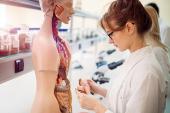CVD, Diabetes Spike in Acute Phase of COVID-19
Diabetes risk lingers for several months, and clinicians should recommend preventive measures to address it, a researcher says.

Among individuals without preexisting diabetes or CVD, COVID-19 is associated with a substantial increase in both diseases during the acute phase of the illness, followed by a waning in risk over the next several months, according to data from family practices in the United Kingdom.
For CVD, the greatest increases were seen for pulmonary embolism, atrial arrhythmias, and venous thrombosis, although rates of MI, heart failure, and stroke were higher for patients with versus without COVID-19, too. Risk for all of these events, however, returned to baseline levels after about 3 months.
In contrast, the heightened threat of diabetes seemed to linger for a bit longer, up to about 23 weeks, researchers led by Emma Rezel-Potts, PhD (King’s College London, England), report in a study published online in PLOS Medicine.
“It’s important to note that this risk of diabetes does extend beyond that acute stage of infection,” Rezel-Potts told TCTMD. “As a clinician, it’s possible to think about mitigating the risk of diabetes—so, recommendations for healthy eating, exercise, things that doctors know about to reduce diabetes risk. It might be a good time to target those preventative measures with patients when they’re in that COVID-19 recovery phase.”
Early on in the pandemic, COVID-19 revealed itself as more than a respiratory illness, striking multiple organ systems within the body. It’s been associated with new-onset CVD and diabetes previously, but the potential impact on longer-term cardiometabolic outcomes has remained unclear.
Now that the world has been wrestling with the spread of SARS-CoV-2 for more than 2-and-a-half years and data have been accumulating, the research community is in a position to start answering that question, Rezel-Potts said.
For the current study, she and her colleagues turned to the Clinical Practice Research Datalink Aurum database, examining electronic health records from 1,356 UK family practices that cover a population of about 13.4 million patients. After excluding those with preexisting diabetes or CVD more than a year before the index date, they matched 428,650 patients diagnosed with COVID-19 with an equal number of patients without COVID-19 (median age 35 years; 56% women).
In the months before the index date, diabetes and CVD rates were higher in patients who would go on to be diagnosed with COVID-19, though there was a substantial increase in both outcomes during the acute COVID-19 phase.
The incidence of diabetes (per 100,000 patient-weeks) was 23.79 in the COVID-19 group and 9.48 in the controls in the initial 4 weeks after diagnosis. Rates declined after that period, but among those who had survived the infection, they remained somewhat higher from 5 to 12 weeks (19.54 vs 11.10 per 100,000 patient-weeks) and from 13 to 52 weeks (19.57 vs 13.17 per 100,000 patient-weeks).
It might be a good time to target those preventative measures with patients when they’re in that COVID-19 recovery phase. Emma Rezel-Potts
The spike in CVD during the acute COVID-19 phase was even greater than what was seen for diabetes (76.92 vs 7.31 per 100,000 patient-weeks), with increased risks of a multitude of CV conditions. Risk remained higher compared with controls from 5 to 12 weeks (22.06 vs 8.41 per 100,000 patient-weeks), but the gap closed over the rest of the year (12.63 vs 9.09 per 100,000 patient-weeks).
In an adjusted, difference-in-difference analysis accounting for baseline rates, the incidence of diabetes was greater in the COVID-19 group in the first 4 weeks (rate ratio 1.81; 95% CI 1.51-2.19) and from 5 to 12 weeks (RR 1.27; 95% CI 1.11-1.46), just falling shy of significance beyond that point (RR 1.07; 95% CI 0.99-1.16).
CVD incidence was significantly higher during the acute phase (RR 5.82; 95% CI 4.82-7.03) and from 5 to 12 weeks (RR 1.49; 95% CI 1.28-1.73). From 13 to 52 weeks, patients who had recovered from COVID-19 actually had a lower risk compared with controls (RR 0.80; 95% CI 0.73-0.88 after adjustment). It’s possible, Rezel-Potts speculated, that after being treated for COVID-19, these patients also received intensified care for other medical issues, which would have lowered their CV risk.
She and her colleagues caution, however, that the analyses were based on electronic health records, raising the possibility that patients’ exposures and outcomes could have been misclassified. Also, because of the observational nature of the study, no conclusions about causality can be made.
Vigilance Needed After a COVID-19 Diagnosis
Commenting for TCTMD, Colin Berry, MBChB, PhD (British Heart Foundation Glasgow Cardiovascular Research Centre, University of Glasgow, Scotland), whose group recently reported on evidence of heart, lung, and kidney injury lasting up to 2 months after a COVID-19 hospitalization, said he wasn’t surprised by the findings. The contribution of the study, he said, is that it affirms the higher risks of CVD and diabetes in a large, reasonably representative data set.
One potential drawback is that the control group—patients who were not diagnosed with COVID-19—may not be optimal, Berry said. He indicating that a comparison with patients with a non-COVID illness like community-acquired pneumonia may have been more appropriate, because it would have provided insights into how much of the observed risk is unique to COVID-19.
Nevertheless, he said, “it’s clear that diabetes incidence increases following COVID and then tends to fall away again,” which “highlights how acute illness can lead to dysregulation or impairment of glucose control.” That might be related to a number of factors, including an increase in insulin resistance in the context of acute illness, direct effects of SARS-CoV-2 on the pancreas or peripheral tissues, or effects on how glucose is removed from blood into adipose tissue, Berry added. “So glucose homeostasis is disturbed in COVID-19, but perhaps the disturbance is more pronounced than would be expected with other forms of illness.”
For Berry, the heightened risk of diabetes in particular after COVID-19 “highlights the need for continuity of care and access to care.” There is a concern, he said, that after recovering from COVID-19 and returning home, individuals might develop diabetes that goes undiagnosed.
To combat that issue, effective healthcare systems that deliver public messaging, medical advice, and access to tests for diabetes in community pharmacies and primary care practices are important, he suggested. “All of these aspects would be relevant.”
Todd Neale is the Associate News Editor for TCTMD and a Senior Medical Journalist. He got his start in journalism at …
Read Full BioSources
Rezel-Potts E, Douiri A, Sun X, et al. Cardiometabolic outcomes up to 12 months after COVID-19 infection. A matched cohort study in the UK. PLoS Med. 2022;Epub ahead of print.
Disclosures
- Rezel-Potts reports support by the NIHR Biomedical Research Centre at Guy’s and St Thomas’ NHS Foundation Trust in partnership with King’s College London.





Comments